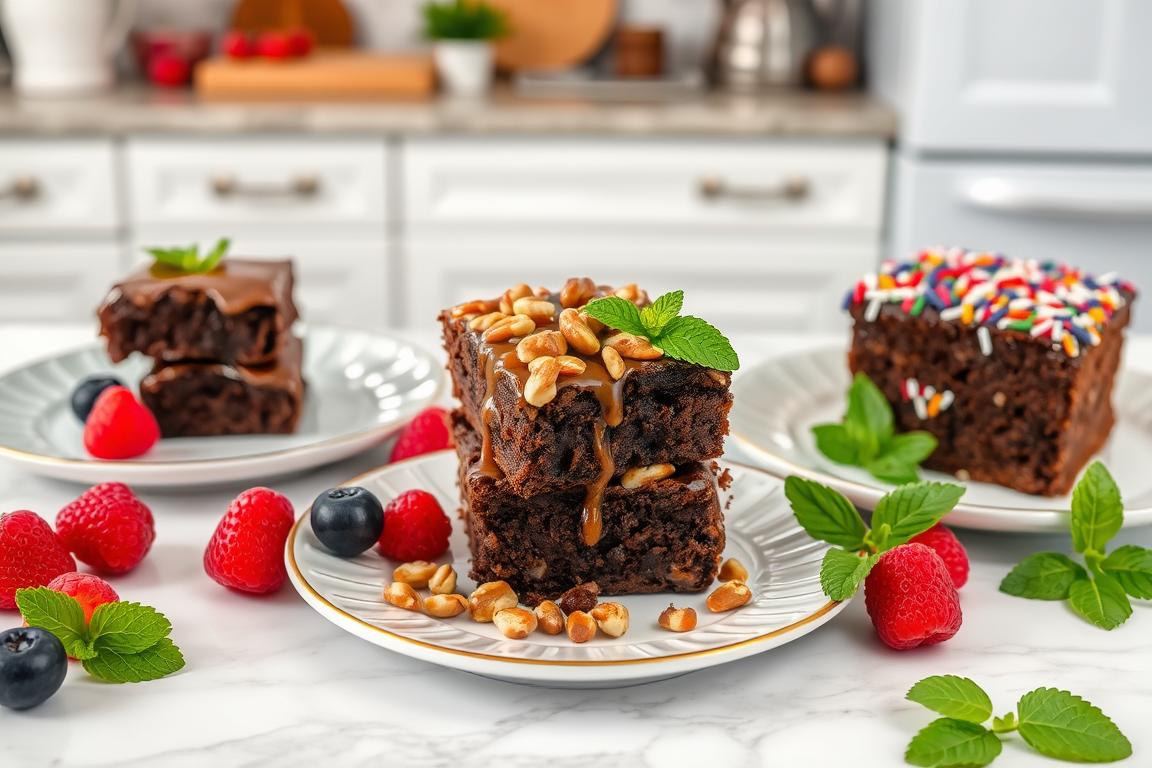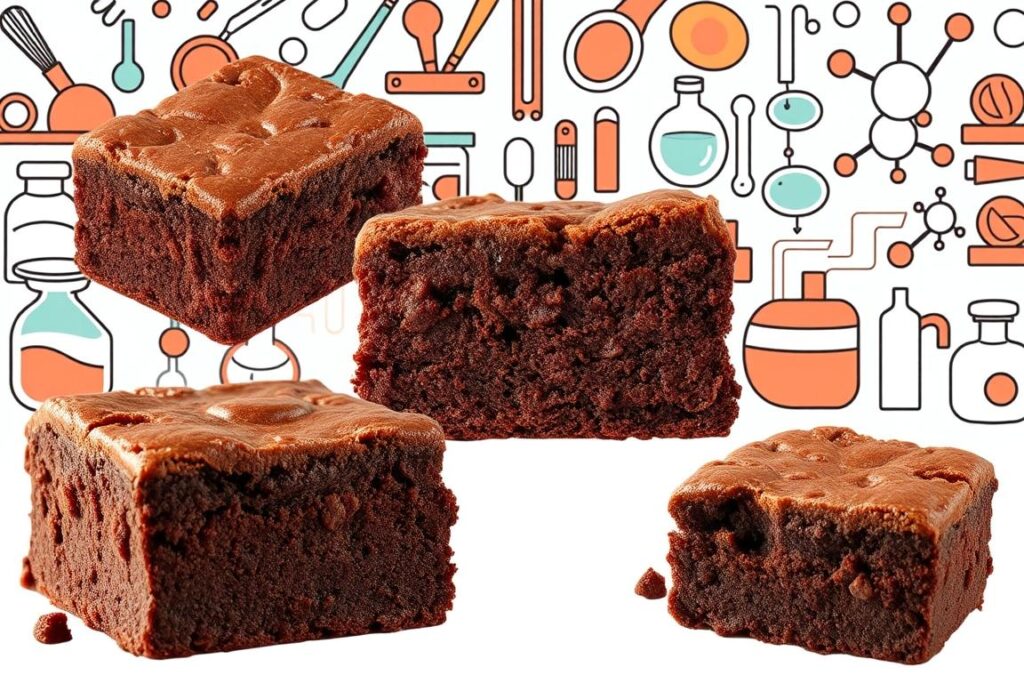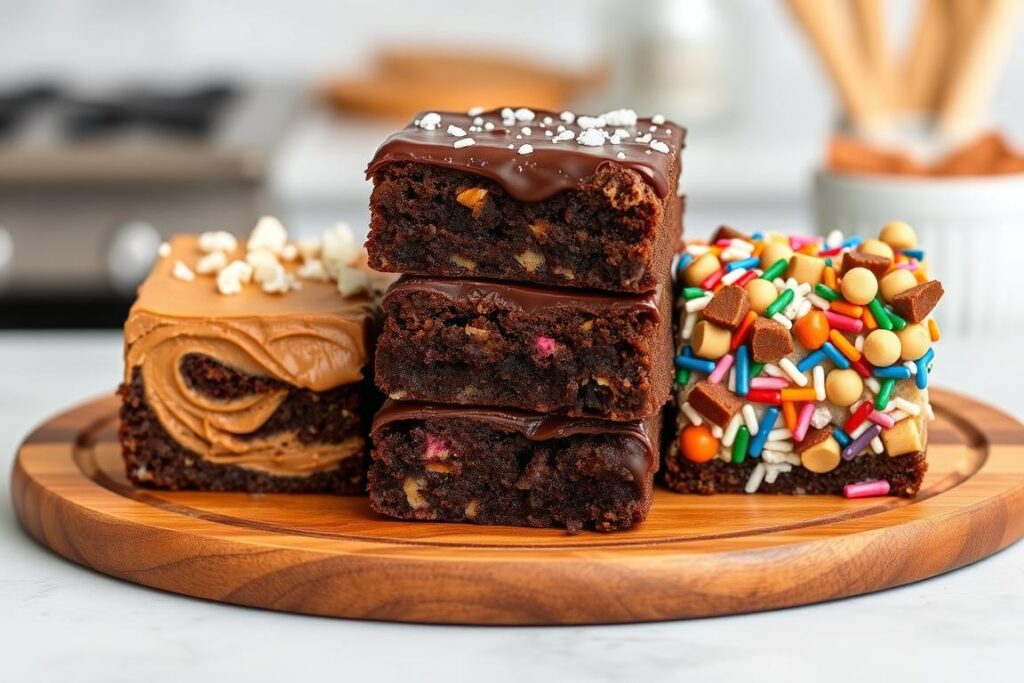Brownies are a favorite American dessert with three main types: fudgy, cakey, and chewy. Each type has its own special qualities. Fudgy brownies are rich and dense. Cakey brownies are light and fluffy. Chewy brownies are a mix of both.
The texture and taste of brownies depend on the fat to flour ratio in the recipe. Knowing about these types helps you pick or make the perfect brownie for yourself.
Key Takeaways
- Brownies come in three main varieties: fudgy, cakey, and chewy.
- The texture of brownies is determined by the ratio of fat to flour in the recipe.
- Fudgy brownies have a dense, moist texture, while cakey brownies are light and fluffy.
- Chewy brownies strike a balance between fudgy and cakey, offering a slightly gooey yet structured bite.
- Choosing the right type of brownie depends on individual taste preferences.
Understanding the History and Evolution of Brownies
Brownies, a classic American dessert, have a rich history. The first recipe appeared in the 1897 Sears Roebuck catalog. This marked the start of brownies as we know them today.
Origins of the Classic American Dessert
The Palmer House Hotel in Chicago first served brownies in 1893. Bertha Honoré Palmer, a chef, created the original recipe. It had lots of chocolate, butter, sugar, and eggs, making it dense and fudgy.
How Brownies Became a Household Favorite
Over time, brownies changed from a simple treat to a favorite dessert. The Bangor Brownies recipe in 1905 was close to today’s brownies. Fannie Farmer’s 1906 book had a simpler version with molasses and cocoa. As recipes evolved, brownies became a staple in homes, with many variations online today.
The Development of The Three Types Of Brownies
As brownies grew in popularity, different styles emerged. Popular flavors include Triple Chocolate, Chocolate Fudge, Salted Caramel, Peanut Butter, Chocolate Orange, Raspberry, and White Chocolate or Blondies. These flavors show how brownies have become a versatile dessert.
Brownies have a long journey from the Palmer House Hotel. Today, they are a cherished American dessert. They continue to evolve, offering a wide range of brownie history and brownie evolution for dessert lovers.
What Are The Three Types Of Brownies?
Brownies come in three main textures: fudgy, cakey, and chewy. These differences come from how ingredients are mixed and how they’re baked. Each type gives a unique taste experience for chocolate fans.
Fudgy Brownies are all about being rich and chocolatey. They have more fat than other types, making them gooey inside and shiny on top. They’re a dream for anyone who loves chocolate.
Cakey Brownies are lighter and fluffier, like a moist chocolate cake. They have less fat and more flour, making them airy and less dense. They’re great for those who prefer a lighter dessert.
Chewy Brownies are a mix of fudgy and cakey. They have a dense center and chewy edges. This makes every bite a delight.
| Brownie Type | Fat-to-Flour Ratio | Texture | Key Characteristics |
|---|---|---|---|
| Fudgy | Higher | Dense, Gooey | Rich, Intense Chocolate Flavor |
| Cakey | Lower | Light, Airy | Resembles Chocolate Cake |
| Chewy | Balanced | Dense, Slightly Gooey | Chewy Edges, Satisfying Texture |
These brownie varieties cater to different tastes. They’re perfect for brownie enthusiasts and chocolate lovers. Knowing about brownie textures helps bakers make the ideal brownie for any occasion.
“There’s nothing quite like a perfectly baked brownie, whether it’s fudgy, cakey, or chewy – it’s a classic dessert that never fails to satisfy.”
Fudgy Brownies: The Ultimate Chocolate Indulgence
For those who love chocolate, fudgy brownies are the best. They are dense, moist, and satisfy any chocolate craving. The secret to their fudgy texture is in the ingredients and how they are baked.
Key Ingredients for Fudgy Texture
The perfect fudgy brownie has a lot of fat compared to flour. The ingredients that make it special are:
- Melted butter: It makes the brownies creamy and indulgent.
- Bittersweet or unsweetened chocolate: This gives the brownies a deep, rich chocolate taste.
- Extra egg yolks: They help make the brownies dense and truffle-like.
Perfect Baking Techniques
To get the fudgy texture right, baking is key. It’s important not to overbake. This can make the brownies dry and cakey. Instead, take them out when they’re still a bit undercooked. This lets the heat inside cook them further, making the center gooey and fudgy.
Characteristics of Fudgy Brownies
Fudgy brownies are known for their deep chocolate taste, dense texture, and truffle-like feel. They are perfect for anyone who loves chocolate and wants a rich, satisfying dessert.
“Fudgy brownies are the ultimate expression of chocolate indulgence. Their dense, moist texture and intense flavor make them a true delight for the senses.”
Cakey Brownies: Light and Fluffy Perfection
Explore the world of cakey brownies, a treat that’s not dense like others. These brownies are light and fluffy, thanks to a special recipe. They mix chocolate’s rich flavor with a soft, cake-like texture.
The secret to cakey brownies is the right mix of ingredients. They have more flour and baking powder than fudgy brownies. This makes them rise and feel airy, like a moist chocolate cake.
Making cakey brownies is different too. Instead of melting butter, it’s creamed with sugar. This adds air, making the brownies light.
This results in a cakey brownie recipe with a balanced chocolate taste. They’re sweeter and less intense, perfect for those who like a lighter dessert. They’re great for anyone who loves chocolate but wants something less rich.
“Cakey brownies are the perfect compromise for those who love the taste of chocolate but desire a lighter, more airy texture in their dessert.”
Looking for a tasty treat or a baking option? The cakey brownie recipe will impress you. Enjoy the perfect mix of chocolate and cake with every bite.
Chewy Brownies: The Best of Both Worlds
Indulge in the perfect balance of fudgy and cakey textures with chewy brownies. This style combines the rich, dense qualities of fudgy brownies with the satisfying chewiness of cakey ones. The secret lies in striking the right ingredient ratios and mastering key baking techniques.
Achieving the Perfect Chewy Texture
The key to creating chewy brownies is finding the sweet spot between too much and too little flour. Chewy brownies use more flour than fudgy ones but less than cakey ones. This results in a dense, gooey center with a pleasantly chewy bite around the edges.
Essential Ingredients and Ratios
Achieving the perfect chewy texture starts with the right balance of ingredients. Chewy brownies typically feature a combination of melted butter and sugar. Brown sugar is often used to enhance chewiness. The flour-to-fat ratio is carefully calibrated to deliver the desired texture.
Tips for Chewy Brownie Success
- Bake until the edges are set but the center is still slightly underdone for a moist, chewy interior.
- Let the brownies cool completely before cutting for clean, neat slices.
- Chill the brownies in the refrigerator for an extra chewy, fudgy texture.
With their dense, gooey center and chewy edges, chewy brownies offer the best of both worlds. By mastering the essential ingredients and baking techniques, you can create a decadent treat. This treat satisfies chocolate cravings while providing a delightful textural experience.
| Recipe | Rating | Key Ingredient Ratio | Texture Preference |
|---|---|---|---|
| Handle the Heat’s Chewy Brownies | 4.84 | 1:3 butter to oil | Chewy with crackly top |
| Bigger Bolder Baking’s The Chewy Brownies of Your Dreams | N/A | 1 cup cocoa powder | N/A |
| Delish’s Best-Ever Chewy Brownies | N/A | No chocolate chips/chunks | N/A |
| Cook’s Illustrated’s Chewy Brownies | N/A | Oil to butter ratio key | N/A |
“The winning recipe was chosen based on a blind taste test with multiple participants, and it received a 10/10 rating for its chewy, fudgy, and perfectly balanced texture.”
The Science Behind Brownie Textures
The texture of brownies is a mix of science and art. They can be fudgy or light and airy, depending on ingredients and baking methods. This balance is key to their unique textures.
The fat-to-flour ratio is central to this science. Fudgy brownies have more fat, like butter or chocolate, making them dense and gooey. Cakey brownies, with less fat, are lighter and fluffier.
The type of sugar used also matters. White sugar makes the top crisp, while brown sugar adds moisture and chewiness. Baking powder is important for cakey brownies, as it adds air bubbles for a fluffy texture.
Eggs are crucial for brownie texture. They help the batter set and become gooey. Baking powder works best in cakey brownies, as it helps them hold air bubbles.
To master brownie textures, you need to balance ingredients and techniques. By adjusting the fat-to-flour ratio, sugar type, and leavening agents, you can make many different types of brownies. This way, you can satisfy any taste preference.
Essential Ingredients and Their Impact on The Three Types Of Brownies
When baking the perfect brownies, the right mix of ingredients is key. The balance of fats, flours, sugars, and leavening agents shapes the texture and taste. Each part adds its own special touch to make brownies fudgy, cakey, or chewy.
Fat-to-Flour Ratios
The amount of flour in a recipe affects the brownie’s texture. Less flour makes brownies denser and fudgier, while more flour makes them cakier. Using oil or butter changes the texture and taste. Butter makes brownies cakier, while oil makes them fudgier and enhances chocolate flavor.
Role of Different Sugars
The type and amount of sugar used greatly impacts brownies. Brown sugar makes brownies chewier, while more sugar makes them softer. White sugar, however, creates a crisp, shiny top.
Impact of Leavening Agents
Leavening agents, like baking powder, are vital for cakey brownies. They help brownies rise, making them lighter and airier. Fudgy brownies, on the other hand, use eggs as leavening, making them denser and more decadent.
Understanding the roles of these ingredients lets bakers tweak their recipes. They can aim for their preferred texture and taste in brownies.
“The key to perfect brownies lies in the careful balance of ingredients – from the right fat-to-flour ratio to the perfect blend of sugars and leavening agents.”
Popular Brownie Mix-ins and Variations
Brownies offer endless customization options. From classic add-ins to unique flavors, there’s a brownie for everyone. Whether you like them fudgy, chewy, or cakey, the right mix-ins can make them special.
Ghirardelli’s Dark Chocolate Brownie Mix and Duncan Hines’ Chewy Fudge Brownie Mix are favorites. Ghirardelli has many mixes, like Chocolate Supreme and Double Chocolate. Each mix offers a different taste.
But there’s more to explore. Home bakers have tried dulce de leche, fudgy Oreo, white chocolate, and Baileys-infused brownies. These unique brownies excite the taste buds and show how versatile brownies can be.
| Brownie Variation | Characteristics |
|---|---|
| Dulce de Leche Brownies | Fudgy, rich, and infused with the caramel-like flavor of dulce de leche. |
| Fudgy Oreo Brownies | Intensely chocolatey with a chewy texture and the delightful crunch of Oreo cookies. |
| White Chocolate Brownies | Creamy, decadent, and a delightful departure from the traditional chocolate brownie. |
| Baileys Brownies | Infused with the iconic Irish cream liqueur, offering a sophisticated and indulgent twist. |
Home bakers can add nuts, chocolate chips, fruits, and espresso powder to their brownies. These mix-ins add flavor and texture, making each bite exciting.
Whether you’re a brownie expert or new to baking, there’s always something new to try. The variety of brownie variations and mix-in ingredients lets you be creative. So, go ahead and make your own unique brownie masterpiece.
Mastering Brownie Baking Techniques
Baking the perfect brownies needs precision and detail. From controlling the oven temperature to preparing the pan, these techniques are crucial. They can turn a simple batch into a brownie masterpiece.
Temperature Control Tips
Keeping the oven temperature steady is key for the right brownie texture. For fudgy brownies, use a lower temperature, about 325°F (165°C). This keeps the edges from getting too hard while the center stays gooey.
For cakey brownies, a higher temperature, around 350°F (175°C), is better. It helps them rise and become light and fluffy.
Proper Pan Preparation
Preparing your baking pan right can greatly affect the outcome. Use parchment paper, leaving some overhang for easy removal. This prevents sticking and ensures even baking.
Also, grease the pan with butter or non-stick spray. This makes the brownies easier to remove.
Testing for Doneness
Finding the right baking time for brownies is tricky. The toothpick method is the best way to check. For fudgy brownies, the toothpick should have a few moist crumbs. For cakey brownies, it should be mostly clean.
Mastering these techniques will help you make perfect brownies every time. Try different ingredients and baking times to find what works best for you. Being dedicated to baking techniques is the secret to making delicious, crowd-pleasing brownies.
Conclusion
Knowing the differences between fudgy, cakey, and chewy brownies helps bakers make the best brownie guide and dessert options. Each type has its own texture and taste, thanks to certain ingredients and cooking methods. Whether you love the gooey chocolate treats, the light cakey ones, or the chewy mix, this guide helps you enjoy these brownie guide favorites.
From the thick, fudgy chocolate fudge brownies to the fancy Nutella ones, brownies keep getting better. Now, bakers can make brownies that fit any dessert options and chocolate treats desire.
The love for brownies shows no signs of fading. They’re perfect for a cozy treat or a fancy dessert. Brownies have become a classic, loved by many for their versatility and deliciousness.
FAQ
What are slutty brownies and why are they called that?
Slutty brownies are a rich, indulgent dessert. They have three layers: chocolate chip cookie dough, Oreo cookies, and fudgy brownies. The name “slutty” is meant to be funny, showing the dessert’s rich, over-the-top nature.
How do fudgy, cakey, and chewy brownies differ in texture and flavor?
Fudgy brownies are dense and rich, with a gooey center. They taste intensely chocolatey. Cakey brownies are lighter and more like chocolate cake. Chewy brownies are dense but have a gooey center and chewy edges.
What are the key ingredients and techniques that define each brownie type?
Fudgy brownies use more butter and chocolate. Cakey brownies have more flour and leavening agents. Chewy brownies mix melted butter and sugar for a balance.
How does the science of baking affect the texture of brownies?
The ratio of fat to flour, sugar type, and leavening agents matter a lot. More fat makes brownies fudgy, while less makes them cakey. Sugar and leavening agents also affect the texture.
What are some popular mix-ins and variations for brownies?
Popular mix-ins include nuts, chocolate chips, fruits, and caramel. You can also add peanut butter, mint, or espresso powder. These add unique flavors and textures to brownies.
What are the essential tips for mastering brownie baking?
For perfect brownies, use high-quality chocolate and measure ingredients carefully. Avoid overmixing and prepare your pan well. Check for doneness accurately. These steps ensure delicious results, no matter the type.



